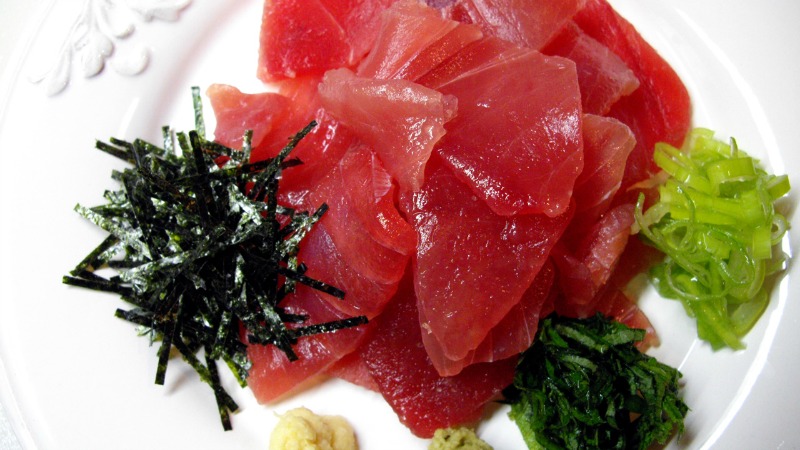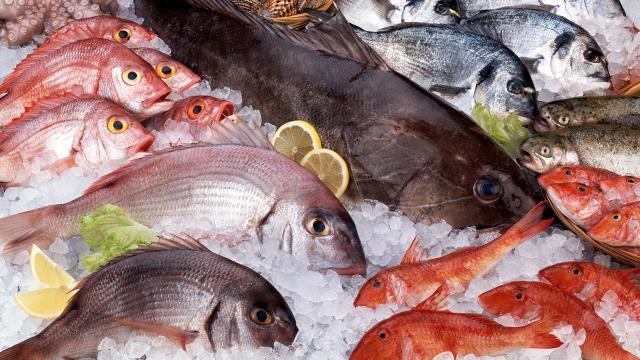Raw fish preparations like sashimi, gravlax and crudo may seem like something you should only trust the professionals with but, if you know your stuff, you can actually buy, prepare and enjoy the raw stuff in the cosy comfort of your own home.
Image by ac_bnphotos via Getty.
What to Look for When Buying Fin Fish
If you’ve looked into eating raw finned creatures before, you’ve probably seen or heard the terms “sushi grade” or “sashimi grade”. It sure sounds like the fish you’re looking for, but the term is essentially meaningless. It’s usually used by stores to mean the “highest quality stuff we got”, but “sushi grade” is a completely unregulated term, meaning fish sellers are free to slap it on whatever they wish without consequence.
You should be constantly vigilant when purchasing fishes that won’t see a lick of heat. This means asking a lot of questions and using your various senses to detect any fishy business, so to speak. Buying from a fishmonger you know and trust is the way to go, but if you don’t have a relationship with a local seafood slinger, here are a few things you should check for on your first visit:
- Find out where it came from: If your fishmonger can’t immediately tell you where the fish came from, that’s a red flag. A good fish market should have a close relationship with their suppliers, and should be able to tell you when and where it was caught, how far it travelled and how it was handled.
- Make eye contact: Whole fish should still be in possession of their eyes, and — according to the FDA — they should “be clear and bulge a little”.
- Give it a sniff: Good, fresh fish shouldn’t have much of a smell. In fact, if it smells fishy, sour or has an ammonia-like aroma, it should be avoided entirely.
- Touch it: Be sure to ask before touching the merchandise (and use a piece of wax paper or something when doing so) but both whole fish and fillets should have firm, shiny flesh that springs back when pressed.
- Really look at it and check for discoloration: According to the FDA, “fillets should display no discoloration, darkening or drying around the edges”, and whole fish should “have firm, shiny flesh and bright red gills free from milky slime”.
- Ask for more details about salmon: Parasite-prone fish should be frozen beforehand, so ask how your fishmonger handles their salmon intended for raw consumption.
- Look around the shop: In addition to visually examining the fish, you should take a gander at the shop itself. A disorderly or dirty work environment is an indication of a lack of care, and cleanliness is obviously important when dealing with raw seafood.
Also, make sure your fishmonger knows you intend to consume their fish raw. If they seem hesitant or try to talk you out of it, strike them from your list and seek your tuna elsewhere. If the fish at your local purveyor makes it through the above inspection unscathed, chances are you’re good to go. Once purchased, get that fish home quickly and consume it within a day or two. (If you need inspiration on exactly how to do that, we have a few recipes below.)
How to Eat Your Wares
Once you’ve purchased your super fresh, super beautiful fish, you’re ready to prepare and consume it. Given the fact that the whole point of these dishes is highlighting a gorgeous piece of sea meat, the most important part of prep is how you slice it.
Cut It Up

Photo by Yumi Kimura.
Sashimi is simply raw pieces of glorious fish, served with some soy sauce or maybe some yuzu. There’s no cooking involved, but there is a bit of knife work. Helen Rennie can walk you through the whole process in the video above — starting with removing the skin and breaking the fish down into saku blocks — but the basic procedure is this:
- Remove the skin by inserting a boning knife at the tail, grabbing the flap of skin and pulling the skin to the left while slicing to the right. Cut the tail portion off and save for cooking. (It has too much connective tissue for raw eating.)
- Cut out the white line running down the centre of the fish, which can be “unpleasantly chewy” when eaten raw.
- Set the belly aside, and remove the row of pin bones by slicing the flesh away from both sides.
- Remove the bloodline from the middle piece of fish. You now have three saku blocks, pieces of fish divided into sections based on the direction of the grain.
The process is slightly different for salmon, but the video explains the process very clearly, so be sure to watch the whole thing. Once you have your saku blocks, you’re ready to slice. Starting with the fish at a diagonal, take a very sharp knife and, while placing pressure on the left side of the fish, drag the knife through the fish starting at the very back of the knife. Starting at the back is important, as it lets you get clean edges by slicing your fish in one smooth movement. When handling fish with pronounced grain, be sure to slice perpendicular to it, otherwise your sashimi will be chewy. Salmon can be a little tricky — as the grain in the thickest piece can zigzag a bit — so start with an easier fish like tuna to build up your confidence.
Dress It Up

Photo by Dietrich Ayala.
Now that your fish is all broken down into tasty little morsels, you’re ready to eat. How much you want to dress your fish up is up to you, and there are a lot of delicious options:
- Simple Sashimi: Simply lay out your slices on chilled plates with a little soy sauce and wasabi paste. You can either place the soy sauce on the side, or drizzle it on and top with chives and sesame seeds, like Chowhound does here.
- Popular Poke: Poke bowls are super trendy right now, which makes sense because they are filling, customisable and delicious. Just start with some sushi rice and fish of your choice, and go crazy with toppings like avocado, sliced radishes, pickled ginger or even crispy fried shallots or garlic. For an extra pop of flavour, toss the fish with a little soy sauce, ponzu and spring onion before serving. (If you need help making sushi rice, Bon Appetit can show you how.)
- Gorgeous Gravlax: Given the fact that gravlax is cured, it’s a little safer than untreated raw fish from a microbial standpoint, so may be a good dish to start with if you’re a little skittish. There’s also a little more prep work involved, but the results are totally worth it. Daniel Gritzer has a complete guide over at Serious Eats, but the waiting is the hardest part. After soaking a skin-on filet of salmon in a bowl of cold, salty water, remove it, dry it off and sprinkle a mixture of salt, sugar, white pepper and ground caraway and coriander seeds on the skin side of the fish. Place it skin side down in a bed of dill, and rub the other side with more of the mixture. Top with more dill, cover everything with plastic and pop it in the fridge for a day. Remove it from the fridge, flip it over, cover it all up again and return to the ice box for another day or two, until it is cured to your liking. Whip up some tasty mustard sauce (Gritzer has a great recipe) and serve with pumpernickel.
- Cool Crudo: Unlike sashimi, crudo is more ingredient-driven, and may be a better choice if you’re easing yourself into the world of enjoying raw fish. There are a lot of good recipes out there, and most start with a good amount of high-quality olive oil. I’m personally a fan of this one from the Washington Post, which features capers, lemon, basil, shallots and chilli flakes.
With all of the above preparations, make sure to keep everything as chilled as possible until you’re ready to serve, and use chilled plates to keep it extra appealing. Lots of people are fans of the raw stuff, but there’s nothing appealing (or safe) about a plate of room temperature fish.

Comments